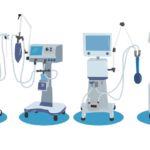Market Overview for the Medical Imaging Equipment Market:
Medical imaging is defined as a blend of varied techniques and processes to gain visual representations of the interior body. The equipment that fulfills the desired objective is referred to as medical imaging equipment. This equipment is used for diagnostic and treatment purposes of various chronic diseases related to the heart, brain, liver, lungs, etc.
Medical imaging equipment consists of a different range of products to fulfill a specific task, these include Magnetic Resonance Imaging (MRI) equipment, Computed Tomography (CT) equipment, ultrasound equipment, X-ray equipment, Molecular Imaging (MI) equipment, and others. According to the market database, X-ray equipment has witnessed a strong share in the market due to the diversified use cases and recent advancements. X-ray systems used in medical imaging are further sub-divided into X-ray digital imaging systems, direct radiography (DR), computed radiography (CR), and X-ray analog imaging systems.
Drivers for the Medical Imaging Sector:
According to the market database, a major driver for this market is the increased demand for the early detection of chronic and acute diseases. Various applications of medical imaging equipment include oncology, cardiology, orthopedics, gynecology, neurology, and others. Diagnostics and treatment of cancer and cardiovascular diseases attract a large pool of patients among the general population.
Hospitals, specialty clinics, diagnostic imaging centers, and others constitute the end-user analysis. Hospitals have experienced a commanding share in the market for the past few years. They provide bundled services to treat and diagnose different diseases. Furthermore, top hospitals provide experienced human staff and advanced technologies which bolsters the efficacy of the procedures and captures the trust of end-user.
Impact of COVID-19 on the Medical Imaging Equipment Market:
COVID-19 has presented some challenges for the medical imaging equipment market as it decreased the overall footfalls of patients in the hospital for diagnostic purposes. According to the market database, the overall market has experienced a negative impact due to COVID-19. There was still a considerable demand for ventilators, vital signs monitoring devices along X-ray and CT equipment during the pandemic. Use cases for magnetic resonance imaging equipment and molecular imaging equipment experienced a decline.
In the post-COVID scenario, the market is expected to rise due to the increased demand for the early detection of cardiovascular diseases. According to a report by World Health Organization (WHO), cardiovascular diseases were the number one cause of death for the year 2016. This accounted for 31% of the global deaths. 85% of the deaths that occurred within cardiovascular diseases were because of heart attacks and strokes.
An independent survey was conducted by the United States Department of Health and Human Services (HHS) in the year 2018. In the United States the heart diseases, strokes, and other cardiovascular threats cost the U.S healthcare system USD 213.8 billion a year. Furthermore, according to the market database, USD 137.4 billion was accounted for a loss in productivity from premature death alone.
Key Players of this market:
Key market players have started to upgrade the equipment with the necessary advancements to offer fast, reliable, and cost-efficient solutions. This is done by improved diagnosis and performance in both standalone and portable equipment.
Betterment in medical equipment is achieved by integrating advanced artificial intelligence (AI) capabilities. This has led to an improvement in descriptive, predictive, and prescriptive analytics for diagnosis and treatment purposes.
Descriptive analytics has allowed capturing improved reports and summarization of patient data and driving strategic decisions. Predictive analytics has provided the ability to detect diseases even before they mutate to advanced stages. This helps taking precautionary measures at an early stage. Prescriptive analytics has witnessed more investments as it allows the market players to drive optimized products and solutions. The growth prospects associated with the Prescriptive analysis market can be studied using Global Market Database. The market intelligence tool studies competitive mapping across various industrial sectors.
For instance, in October 2019, an American healthcare company launched solutions related to imaging techniques. These solutions have been coupled with advanced artificial intelligence (AI) capabilities for clinical departments in applications for radiology, cardiology, and gynecology. The well-crafted solution also has the dual ability to be lightweight and portable.
Various strategies adopted by the market players include product launches, upgrades and enhancements, agreements, patents, partnerships, expansions, and acquisitions. Such rapid developments have led to more cost-effective and innovative solutions in both developed and developing regions.
The North-America market has experienced a strong share due to an increased number of cardiovascular threats and other ailments. Emerging economies such as India and China have also witnessed accelerated penetration in medical imaging equipment. According to the procured market database, this is due to increased investment by the public and private sectors to develop healthcare infrastructure.
For instance, a leading Indian healthcare company in 2019, launched a piece of equipment with advanced artificial intelligence and machine learning capabilities. This equipment can detect cancer at premature stages with more precision and provide the necessary diagnosis. The company has now envisaged deploying such equipment at a broader scale and in various geographical locations.
High cost in such medical imaging equipment acts as a barrier towards accelerated innovation and adoption in underpenetrated nations. According to the market database, the cost of magnetic resonance imaging equipment starts from USD 150,000, and high-end devices cost over USD 1 million. A more concentrated effort is taken up by the equipment makers to overcome the challenges.
The challenges and opportunities associated with an industry vertical can be understood using Global Market Database. The cloud-based market research tool analyzes the demand and growth associated with technology in the market. A greater number of opportunities are explored with a mixture of advanced artificial components coupled with portability. End-users have started to take advantage of more fast, reliable, and cost-efficient solutions. Increased investment by the government to develop healthcare infrastructure is expected to sustain the demand in emerging nations as well as developed nations to improve public health in general.


